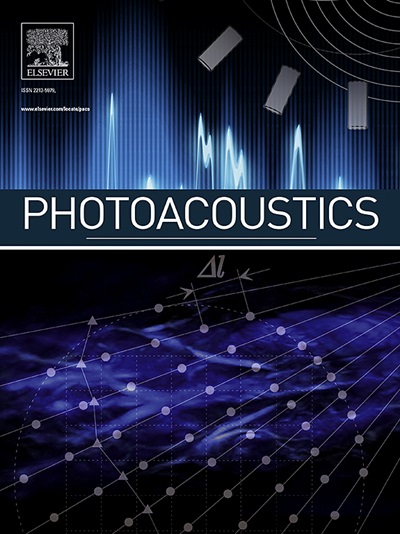超声引导光声图像注释工具箱在MATLAB (PHANTOM)的临床前应用
IF 7.1
1区 医学
Q1 ENGINEERING, BIOMEDICAL
引用次数: 0
摘要
在光声(PA)成像中,深度依赖的影响补偿对于准确定量来自深部组织的发色团至关重要。在这里,我们提出了一个用户友好的工具包,名为PHANTOM (MATLAB光声注释工具包),它包括一个图形界面,并有助于超声引导的PA图像的分割。我们利用Monte Carlo eXtreme对光源配置进行建模,并利用超声三维分割组织生成影响图,以深度补偿PA图像。该方法用于分析具有不同血氧的幻影的PA图像,并通过氧电极测量验证结果。使用PHANTOM工具包对两个临床前模型(皮下肿瘤和钙化胎盘)进行成像和影响补偿,并通过免疫组织化学验证结果。PHANTOM工具包提供脚本和辅助功能,使非光学成像专业的生物医学研究人员能够对PA图像进行影响校正,增强了各个领域研究人员定量PAI的可访问性。本文章由计算机程序翻译,如有差异,请以英文原文为准。
Ultrasound-guided photoacoustic image annotation toolkit in MATLAB (PHANTOM) for preclinical applications
Depth-dependent fluence-compensation in photoacoustic (PA) imaging is paramount for accurate quantification of chromophores from deep tissues. Here we present a user-friendly toolkit named PHANTOM (PHotoacoustic ANnotation TOolkit for MATLAB) that includes a graphical interface and assists in the segmentation of ultrasound-guided PA images. We modelled the light source configuration with Monte Carlo eXtreme and utilized 3D segmented tissues from ultrasound to generate fluence maps to depth compensate PA images. The methodology was used to analyze PA images of phantoms with varying blood oxygenation and results were validated with oxygen electrode measurements. Two preclinical models, a subcutaneous tumor and a calcified placenta, were imaged and fluence-compensated using the PHANTOM toolkit and the results were verified with immunohistochemistry. The PHANTOM toolkit provides scripts and auxiliary functions to enable biomedical researchers not specialized in optical imaging to apply fluence correction to PA images, enhancing accessibility of quantitative PAI for researchers in various fields.
求助全文
通过发布文献求助,成功后即可免费获取论文全文。
去求助
来源期刊

Photoacoustics
Physics and Astronomy-Atomic and Molecular Physics, and Optics
CiteScore
11.40
自引率
16.50%
发文量
96
审稿时长
53 days
期刊介绍:
The open access Photoacoustics journal (PACS) aims to publish original research and review contributions in the field of photoacoustics-optoacoustics-thermoacoustics. This field utilizes acoustical and ultrasonic phenomena excited by electromagnetic radiation for the detection, visualization, and characterization of various materials and biological tissues, including living organisms.
Recent advancements in laser technologies, ultrasound detection approaches, inverse theory, and fast reconstruction algorithms have greatly supported the rapid progress in this field. The unique contrast provided by molecular absorption in photoacoustic-optoacoustic-thermoacoustic methods has allowed for addressing unmet biological and medical needs such as pre-clinical research, clinical imaging of vasculature, tissue and disease physiology, drug efficacy, surgery guidance, and therapy monitoring.
Applications of this field encompass a wide range of medical imaging and sensing applications, including cancer, vascular diseases, brain neurophysiology, ophthalmology, and diabetes. Moreover, photoacoustics-optoacoustics-thermoacoustics is a multidisciplinary field, with contributions from chemistry and nanotechnology, where novel materials such as biodegradable nanoparticles, organic dyes, targeted agents, theranostic probes, and genetically expressed markers are being actively developed.
These advanced materials have significantly improved the signal-to-noise ratio and tissue contrast in photoacoustic methods.
 求助内容:
求助内容: 应助结果提醒方式:
应助结果提醒方式:


